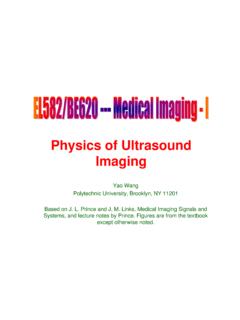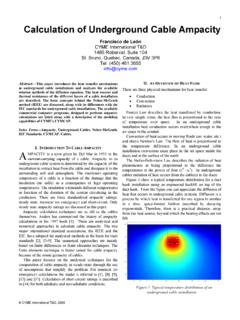Transcription of Characterization of Signals Frequency Domain
1 Frequency Domain Characterization of Signals Yao Wang Polytechnic University, Brooklyn, NY11201. http: ~yao signal Representation What is a signal Time- Domain description Waveform representation Periodic vs. non-periodic Signals Frequency - Domain description Periodic Signals Sinusoidal Signals Fourier series for periodic Signals Fourier transform for non-periodic Signals Concepts of Frequency , bandwidth, filtering Numerical calculation: FFT, spectrogram Demo: real sounds and their spectrogram (from DSP First). Yao Wang, 2006 EE3414: signal Characterization 2. What is a signal A variable (or multiple variables) that changes in time Speech or audio signal : A sound amplitude that varies in time Temperature readings at different hours of a day Stock price changes over days Etc . More generally, a signal may vary in 2-D space and/or time A picture: the color varies in a 2-D space A video sequence: the color varies in 2-D space and in time Continuous vs.
2 Discrete The value can vary continuously or take from a discrete set The time and space can also be continuous or discrete We will look at continuous-time signal only in this lecture Yao Wang, 2006 EE3414: signal Characterization 3. Waveform Representation Waveform representation Plot of the variable value (sound amplitude, temperature reading, stock price) vs. time Mathematical representation: s(t). Yao Wang, 2006 EE3414: signal Characterization 4. Sample Speech Waveform 0 0. 0 2000 4000 6000 8000 10000 12000 14000 16000 2000 2200 2400 2600 2800 3000. Entire waveform Blown-up of a section. [y,fs]=wavread(' '); figure; plot(x);. sound(y,fs); axis([2000,3000, , ]);. figure; plot(y);. x=y(10000:25000);plot(x); signal within each short time interval is periodic Period depends on the vowel being spoken Yao Wang, 2006 EE3414: signal Characterization 5. Sample Music Waveform Entire waveform Blown-up of a section [y,fs]=wavread(' '); v=axis.
3 Sound(y,fs); axis([ , , ,.2]). figure; plot(y);. Music typically has more periodic structure than speech Structure depends on the note being played Yao Wang, 2006 EE3414: signal Characterization 6. Sinusoidal Signals s (t ) = A cos(2 f 0t + ) 2. f 0 : Frequency 1. (cycles/second) 0. T0 = 1 / f 0 : period -1. A : Amplitude : Phase (time shift). -2. -1 0 1 Sinusoidal Signals are important because they can be used to synthesize any signal An arbitrary signal can be expressed as a sum of many sinusoidal Signals with different frequencies, amplitudes and phases Music notes are essentially sinusoids at different frequencies Yao Wang, 2006 EE3414: signal Characterization 7. What is Frequency of an arbitrary signal ? Sinusoidal Signals have a distinct (unique) Frequency An arbitrary signal does not have a unique Frequency , but can be decomposed into many sinusoidal Signals with different frequencies, each with different magnitude and phase The spectrum of a signal refers to the plot of the magnitudes and phases of different Frequency components The bandwidth of a signal is the spread of the Frequency components with significant energy existing in a signal Fourier series and Fourier transform are ways to find spectrums for periodic and aperiodic Signals , respectively Yao Wang, 2006 EE3414: signal Characterization 8.
4 Approximation of Periodic Signals by Sum of 2 Sinusoids sinusoids: 1 and 3d harmonics st 1.. 0 s (t ) = Ak cos(2 kf 0t ). k =0. -1. -1 0 1 View note for matlab code 4 sinusoids: 1,3,5,7 harmonics With many more sinusoids with appropriate magnitude, we will get the square wave exactly Yao Wang, 2006 EE3414: signal Characterization 9. Line Spectrum of Square Wave Magnitude Spectrum for Square Wave Each line corresponds to one harmonic Frequency . The line magnitude (height) indicates 4. the contribution of that 1 k = 1,3,5,.. Ak = k Frequency to the signal . 0 k = 0,2,4,.. The line magnitude drops Amplitude exponentially, which is not very fast. The very sharp transition in square waves calls for very high Frequency sinusoids to synthesize. 0. 1 3 5 7 9 11 13 15. k,fk=f0*k Yao Wang, 2006 EE3414: signal Characterization 10. Period signal Period T: The minimum interval on which a signal repeats Sketch on board Fundamental Frequency : f0 =1/T.
5 Harmonic frequencies: kf0. Yao Wang, 2006 EE3414: signal Characterization 11. Approximation of Periodic Signals by Sinusoids Any periodic signal can be approximated by a sum of many sinusoids at harmonic frequencies of the signal (kf0 ) with appropriate amplitude and phase. The more harmonic components are added, the more accurate the approximation becomes. Instead of using sinusoidal Signals , mathematically, we can use the complex exponential functions with both positive and negative harmonic frequencies Yao Wang, 2006 EE3414: signal Characterization 12. Complex Exponential Signals Complex number: A = A exp( j ) = A cos + j A sin = Re + j Im Complex exponential signal s (t ) = A exp( j 2 f 0t ) = A cos(2 f 0t + ) + j A sin( 2 f 0t + ). Euler formula exp( j t ) + exp( j t ) = 2 cos( t ). exp( j t ) exp( j t ) = j 2 sin( t ). Yao Wang, 2006 EE3414: signal Characterization 13.
6 Fourier Series Representation of Periodic Signals Fourier Series Synthesis (inverse transform) : . s (t ) = A0 + Ak cos(2 kf 0t + k ) (single sided, for real signal only). k =1.. = S. k = . k exp( j 2 kf 0t ) (double sided, for both real and complex). Fourier series analysis (forward transform) : 1 T0. S k=. T0 0. s (t ) exp( j 2 kf 0t ) dt ; k = 0, 1,2,.. S k is in general a complex number For real Signals , Sk=S*-k |Sk|=|S-k| (Symmetric spectrum). Yao Wang, 2006 EE3414: signal Characterization 14. Fourier Series Representation of Square Wave Applying the Fourier series analysis formula to the square wave, we get 2. k = 1,3,5,.. S k = j k 0 k = 0, 2,4,.. Do the derivation on the board Yao Wang, 2006 EE3414: signal Characterization 15. Line Spectrum of Square Wave Magnitude Spectrum for Square Wave 4. k = 1,3,5,.. 1 Ak = k 0 k = 0,2,4,.. Amplitude Only the positive Frequency side is drawn on the left (single sided spectrum), with twice the magnitude of the 0 double sided spectrum.
7 1 3 5 7 9 11 13 15. k,fk=f0*k Yao Wang, 2006 EE3414: signal Characterization 16. Fourier Transform for Non-Periodic Signals Aperiodic signal T 0= f 0 = 0 uncountable number of harmonics integral instead of sum Fourier synthesis (inverse transform) : . s (t ) = S ( f ) exp( j 2 ft )df . Fourier analysis (forward transform) : . S(f) = s(t ) exp( j 2 ft )dt . For real Signals , |S(f)| =|S(-f)| (Symmetric magnitude spectrum). Yao Wang, 2006 EE3414: signal Characterization 17. Pulse Function: Time Domain A Rectangular Pulse Function 1. s(t). T. 0. -1 0 1. t 1 T / 2 < t < T / 2. s (t ) = . Derive Fourier transform on the board 0 otherwise Yao Wang, 2006 EE3414: signal Characterization 18. Pulse Function: Spectrum Magnitude Spectrum of Rectangular Pulse 1. The peaks of the FT. magnitude drops slowly. |S(f)|. This is because the pulse function has sharp transition, which 0 contributes to very high Frequency in the signal .
8 -10 -8 -6 -4 -2 0 2 4 6 8 10. f 1 T / 2 < t < T / 2 sin( Tf ). s (t ) = S( f ) = T = T sinc(Tf ). 0 otherwise Tf Yao Wang, 2006 EE3414: signal Characterization 19. Exponential Decay: Time Domain 1. s(t)=exp(- t), t>0); =1. s(t). 0. 0 1 2 3 4 5. t exp( t ) t >0 1 1. s (t ) = S( f ) = ; S( f ) =. 0 otherwise + j 2 f 2 + 4 2 f 2. Yao Wang, 2006 EE3414: signal Characterization 20. Exponential Decay: Spectrum 1. S(f)=1/( +j 2 f), =1. |S(f)|. The FT magnitude drops much faster than for the pulse function. This is because the exponential decay function does not has sharp transition. 0. -10 -8 -6 -4 -2 0 2 4 6 8 10. f exp( t ) t >0 1 1. s (t ) = S( f ) = ; S( f ) =. 0 otherwise + j 2 f 2 + 4 2 f 2. Yao Wang, 2006 EE3414: signal Characterization 21. (Effective) Bandwidth 1. fmin (fma): lowest (highest). Frequency where the FT magnitude is above a threshold Bandwidth: B=fmax-fmin The threshold is often chosen with respect to the peak magnitude, B expressed in dB.
9 DB=10 log10(ratio). 0 10 dB below peak =. -10 -8 -6 -4 -2 0 2 4 6 8 10 1/10 of the peak value 3 dB below=1/2 of the fmin fmax peak Yao Wang, 2006 EE3414: signal Characterization 22. More on Bandwidth Bandwidth of a signal is a critical feature when dealing with the transmission of this signal A communication channel usually operates only at certain Frequency range (called channel bandwidth). The signal will be severely attenuated if it contains frequencies outside the range of the channel bandwidth To carry a signal in a channel, the signal needed to be modulated from its baseband to the channel bandwidth Multiple narrowband Signals may be multiplexed to use a single wideband channel Yao Wang, 2006 EE3414: signal Characterization 23. How to Observe Frequency Content from Waveforms? A constant -> only zero Frequency component (DC compoent). A sinusoid -> Contain only a single Frequency component Periodic Signals -> Contain the fundamental Frequency and harmonics -> Line spectrum Slowly varying -> contain low Frequency only Fast varying -> contain very high Frequency Sharp transition -> contain from low to high Frequency Music: contain both slowly varying and fast varying components, wide bandwidth Highest Frequency estimation?
10 Find the shortest interval between peak and valleys Go through examples on the board Yao Wang, 2006 EE3414: signal Characterization 24. Estimation of Maximum Frequency Blown-Up of the signal S(t). 0. 2450 2460 2470 2480 2490 2500 2510 2520 2530 2540 2550. Time index Yao Wang, 2006 EE3414: signal Characterization 25. Numerical Calculation of FT. The original signal is digitized, and then a Fast Fourier Transform (FFT) algorithm is applied, which yields samples of the FT at equally spaced intervals. For a signal that is very long, a speech signal or a music piece, spectrogram is used. Fourier transforms over successive overlapping short intervals Yao Wang, 2006 EE3414: signal Characterization 26. Spectrogram S(t). 0. FFT. FFT. FFT. FFT FFT. FFT. 2000 2200 2400 2600 2800 3000. t Yao Wang, 2006 EE3414: signal Characterization 27. Sample Speech Waveform (click to hear the sound).
















